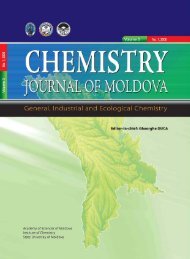stiinte med 1 2012.indd - Academia de ÅtiinÅ£e a Moldovei
stiinte med 1 2012.indd - Academia de ÅtiinÅ£e a Moldovei
stiinte med 1 2012.indd - Academia de ÅtiinÅ£e a Moldovei
Create successful ePaper yourself
Turn your PDF publications into a flip-book with our unique Google optimized e-Paper software.
428<br />
8. Pacientul cu PC poate să asocieze şi alte manifestări<br />
clinice: epilepsie, retard mental, <strong>de</strong>ficite vizuale,<br />
strabism, nistagmus, <strong>de</strong>ficite auditive, tulburări <strong>de</strong><br />
comportament, tulburări <strong>de</strong> învăţare, <strong>de</strong>ficit <strong>de</strong> concentrare<br />
şi <strong>de</strong> atenţie etc.<br />
9. Diagnosticul pozitiv <strong>de</strong> PC se stabileşte coroborând<br />
anamneza, examenul clinic şi investigaţiile<br />
paraclinice.<br />
10. Examenul neuroimagistic este o investigaţie<br />
recomandată în evaluarea tuturor copiilor cu PC.<br />
RMN este metoda <strong>de</strong> elecţie, <strong>de</strong>oarece conferă informaţii<br />
suplimentare referitoare la etiologia apariţiei<br />
PC.<br />
Bibliografie<br />
1. Aicardi J., Clinics in Developmental Medicine. Disease<br />
of the Nervous System in Childhood. Mackeith Press.<br />
Cambridge University Press. 1998; ed. a 2-a, 822:826.<br />
2. Ashwal S., Russman B.S., Blasco P.A. etc., Practice<br />
parameter: diagnostic assessment of the child with<br />
cerebral palsy: report of the Quality Standards Subcommittee<br />
of the American Aca<strong>de</strong>my of Neurology and the<br />
Practice Committee of the Child Neurology Society, Neurology,<br />
2004; 62(6):851-863.<br />
3. Benga Il., Cristea A., Evaluarea neurologică a copilului.<br />
Editura “Napoca Star”, 2005; 10-56.<br />
4. Burke D., Spasticity as an adaptation to pyramidal<br />
tract injury. Adv. Neurol., 1988; 47:401.<br />
5. Christos P. Panteliadis, Hans-Michael Strassburg,<br />
Cerebral Palsy principles and management. Georg Thieme<br />
Verlag., 2004; 61-86.<br />
6. Dragomir D., Pleşca D., Paraliziile cerebrale.<br />
Tratat <strong>de</strong> Pediatrie, prima ediţie, Bucureşti: Editura Medicală,<br />
2002.<br />
7. Jahnson A. Prevalence and characteristics of<br />
children with cerebral palsy in Europe, Dev. Med. Chid.<br />
Neur., 2002; 44:633-641.<br />
8. Pleşca D., Hurduc V., Ioan Iu., Evaluarea copilului<br />
cu paralizie cerebral, Revista Română <strong>de</strong> Pediatrie.<br />
2010, LIX (2):81-5.<br />
9. Popescu V., Zamfirescu A., Diagnosis in pediatric<br />
neurology. Revista Română <strong>de</strong> Pediatrie, 2010, LIX<br />
(2):103-114.<br />
10. Popescu V., Arion C., Dragomir D. ş.a., Neurologie<br />
pediatrică. Curs <strong>de</strong> Pediatrie, IMF Bucureşti, Facultatea<br />
<strong>de</strong> Pediatrie, Clinica <strong>de</strong> Pediatrie, Spitalul Clinic <strong>de</strong><br />
Copii ,,23 August”. 1981; p. 135-181.<br />
11. Popescu V., Răduţ Ştefănescu M., Paraliziile cerebrale.<br />
Popescu V.,Neurologie Pediatrică. Bucureşti: Teora,<br />
2001; I;19:528-559.<br />
Rezumat<br />
În studiu a fost apreciat rolul anamnesticului ca o etapă<br />
<strong>de</strong>osebit <strong>de</strong> importantă în evaluarea maturităţii neurologice<br />
a copilului şi în stabilirea diagnosticului neurologic. Au<br />
Buletinul AŞM<br />
fost precizate etapele diagnosticului paraliziei cerebrale<br />
(PC) la copilul cu leziuni cerebrale perinatale: examenul<br />
posturii şi reflexelor <strong>de</strong> <strong>de</strong>zvoltare, tulburările <strong>de</strong> tonus<br />
asociate cu un <strong>de</strong>ficit motor, <strong>de</strong>zvoltarea performanţelor<br />
motorii, tulburările <strong>de</strong> comunicare, prezenţa <strong>de</strong> fenomene<br />
paroxistice convulsivante, retard mental, <strong>de</strong>ficite vizuale,<br />
strabism, nistagmus, <strong>de</strong>ficite auditive, tulburări <strong>de</strong> comportament,<br />
tulburări <strong>de</strong> învăţare, <strong>de</strong>ficit <strong>de</strong> concentrare şi <strong>de</strong><br />
atenţie. S-a constatat că monitorizarea nivelului <strong>de</strong>zvoltării<br />
psihomotorii a copilului în perioada între 0 şi 3 ani ne<br />
va permite să apreciem gradul <strong>de</strong> maturaţie al SNC. Diagnosticul<br />
pozitiv <strong>de</strong> PC se stabileşte coroborând anamneza,<br />
examenul clinic şi investigaţiile paraclinice.<br />
Summary<br />
In this study we assessed the role of anamnesis as a<br />
particularly valuable and important stage of evaluation of<br />
child’s neurological maturity and neurological diagnosis.<br />
The stages of cerebral palsy’s (CP) diagnosis in the child<br />
with perinatal cerebral injuries were presented: examination<br />
of posture and <strong>de</strong>velopmental reflexes, tonus disor<strong>de</strong>rs<br />
associated with motor <strong>de</strong>ficit, <strong>de</strong>velopment of motor<br />
abilities, communication disor<strong>de</strong>rs, presence of convulsive<br />
paroxysmal phenomena, mental retardation, strabismus,<br />
nystagmus, auditory <strong>de</strong>ficits, behavior disor<strong>de</strong>rs, learning<br />
disor<strong>de</strong>rs, and concentration and attention <strong>de</strong>ficits. We<br />
observed that the assessment of child’s psychomotor<br />
<strong>de</strong>velopment between 0 and 3 years old would allow us<br />
to <strong>de</strong>termine the level of maturation of CNS. The positive<br />
diagnosis of CP would be established in corroboration<br />
with anamnesis, clinical examination and paraclinical<br />
investigations.<br />
Резюме<br />
В работе была оценена роль анамнеза как очень<br />
важный этап в оценке развития ЦНС и подтверждения<br />
диагноза. Были сформулированы этапы диагностики<br />
ДЦП у ребенка с перинатальным поражением головного<br />
мозга: наблюдение позы и рефлексов развития, нарушение<br />
тонуса в ассоциации с двигательным дефицитом,<br />
развитие двигательных способностей, расстройство<br />
общения, присутствие пароксизмальных конвульсивных<br />
феноменов, задержка нервно-психического развития,<br />
нарушение зрения, косоглазие, нистагм, дефицит<br />
слуховых реакций, поведенческие расстройства, дефицит<br />
внимания и плохая концентрация. Было установлено,<br />
что наблюдение психомоторного развития ребенка<br />
в период от 0 до 3 лет позволит оценить степень созревания<br />
центральной нервной cистемы. Положительный<br />
диагноз ДЦП определяется при совмещении анамнеза,<br />
клинического осмотра и лабораторных исследований.

















